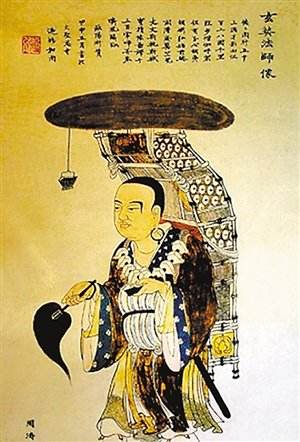Xuanzang
2 min readXuanzang(Wade-Giles:Hsian-tsang)(599-664)was a famous Chinese Buddhist monk.Xuanzang was born near Luoyang,Henan in 599 as Chen Yi and died 664 in Yu Hua Gong.He came from a scholarly family.He became famous for his seventeen year-long trip to India,during which he studied with many famous Buddhist masters,especially at the famous center of Buddhist learning in Nalanda.When he returned,he brought with him some 657 Sanskrit texts.With the emperor’s support,he set up a large translation bureau in Chang’an(present-day Xi’an),drawing students and collaborators from all over East Asia.He is credited with the translation of some 1330 fascicles of scriptures into Chinese.His strongest personal interest in Buddhism was in the field of Yogacora or Consciousness-only.
The force of his own study,translation and commentary of the texts of these traditions initiated the development of the Faxiang school in East Asia.
Although the school itself did not thrive for a long time,its theories regarding perception,consciousness,karma,rebirth,etc.found their way into the doctrines of other more successful schools.Xuanzang’s closest and most eminent student was Kuiji who became recognized as the first patriarch of the Faxiang school.

Names
Xuanzang is also known by the Cantonese transcription of his title,Tang Sanzang,as Tong Sam Jong.Less common romanizations of Xuanzang include HhuenKwan,Hiouen Thsang,Hiuen Tsiang,Hsien-tsang,Hsuan Chwang,Hsuan Tsiang,Hwen Thsang,Xuan Cang,Xuan Zang,Shuen Shang,Yuan Chang,Yuan Chwang,and Yuen Chwang.
In Japanese,he is known as Genjo or Sanzo.
Legacy
In 646,under the Emperor’s request,Xuanzang completed his book Records of the Western Regions of the Great Tang Empire,which has become one of the primary sources for the study of medieval history in India.This book was firsttranslated into French by Sinologist Stanislas Julien in 1857.There was also a biography of Xuanzang written by the monk Huili.Both books were first translatedinto English by Samuel Beal,in 1884 and 1911 respectively.An English translation with copious notes by Thomas Watters was edited by T.S.Rhys Dadivds and S.W.
Bushe11,and published posthumously in London in 1905.
Xuanzang’s journey along the so-called Silk Roads,and the legends that grew up around it,inspired the Ming novel Journey to the West,one of the great classics ofChinese literature.The Xuanzang of the novel is the reincarnation of a disciple of Gautama Buddha,and is protected on his journey by three notorious monsters.One ofthem,the monkey,was a popular favourite and profoundly influenced Chinese culture and contemporary Japanese manga(including the popular Dragon Ball series),and became well known in the West by Arthur Waley’s translation and later the cult TV series Monkey.








